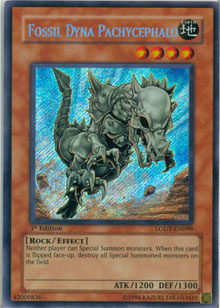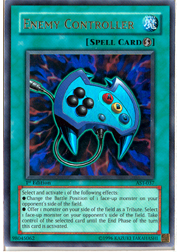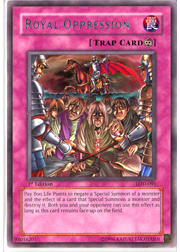This week’s decklist balances the line between expenses. If you’re looking for a way play at a very competitive level while still keeping things well below the price range of other strategies, this might be the answer you’re looking for. Furthermore, the deck requires rather straightforward play and doesn’t force much player-reading, decision-making, or complex choices during your duels. It isn’t too difficult to play a perfect game.
This deck is a blend of the aggro and control concepts, relying on its ability to generate dead cards and stop your opponent while delivering blows with large monsters. The release of Thunder King Rai-Oh brought the strategy to a competitive level, locking down almost every other competitive deck in the game. It forces Tele-DAD decks to play at a normal pace: a pace that keeps them from competing with beatdown play patterns. Gladiator Beast decks are limited in their ability to special summon, which can be a disaster for them. They’ll also have great difficulty dealing with the brute size of your monsters, and you’ll force a lot of early plays of Gladiator Beast Gyzarus and acts of desperation. Against Gladiator Beasts, the ability to control when your opponent can play Gyzarus makes you a large favorite to win.
The build plays like a Gadget deck without Gadget monsters. This makes it more reliant on the survival of monsters, which is its weakness. However, most popular decks can’t destroy your monsters without using a special summon or some complex but powerful combo. Gone are the days of triple Sakuretsu Armor, and we’re looking to take advantage of that by not allowing our opponent to clear our field using monster effects.
The Monsters
 The monster lineup is something unique. We’re packing fifteen monsters designed to limit opponents’ options, allowing an indirect advantage over the opposition while being large enough to withstand battle with most monsters.
The monster lineup is something unique. We’re packing fifteen monsters designed to limit opponents’ options, allowing an indirect advantage over the opposition while being large enough to withstand battle with most monsters.
King Tiger Wanghu is a powerhouse against both Gladiator Beasts and TeleDAD decks. Your Gladiator Beast opponents can’t use Gladiator Beast Murmillo to clear your field, forcing them to use either Gladiator Beast Laquari or Gladiator Beast Gyzarus (the latter being a difficult feat for an opponent under Wanghu’s lock). Your TeleDAD opponents won’t be able to use their copies of Krebons or Destiny Hero - Malicious while Wanghu is on the field, severely limiting their options.
Fossil Dyna Pachycephalo has been a wondrous card since its release. It’s large enough to battle about half your opponent’s monsters, possibly less. While its ATK isn’t high enough to justify a beatdown strategy, protecting it with your spells and traps can force an opponent’s strategy to fold under its own weight.
Thunder King Rai-Oh might as well be named "King of the anti-meta," as he slows almost every opponent. Many cards in TeleDAD, like Elemental Hero Stratos and Reinforcement of the Army, become completely useless while he’s on the field. You can even negate the summon of Dark Armed Dragon or Gyzarus, which creates an interesting situation that defines the deck: you play one card, and your opponent will often be forced to expend many cards or combos to deal with the threat. While your opponent’s cards have much more potential than yours do, the ease with which you can pose threats will be your strength. It’s pretty easy to summon one of your monsters: you just place it on the field. For your opponent to respond, he or she will have to get three Darks in the graveyard, or have two Gladiator Beast monsters on the field, or find a way to Synchro summon, or make some other elaborate and powerful move that will, in the end, only destroy your one card. Your ability to repeat that process will leave your opponents devoid of tricks rather quickly.
Drillroid may seem a strange choice, but this deck forces opponents into a defensive state rather quickly. You need to have a way to respond to an opponent who climbs into a shell. Otherwise you’ll sit there drawing cards until your opponent draws exactly what he or she needs. Drillroid allows you to take advantage of a weakened opponent and widen your lead, if not win the game outright.
Banisher of the Radiance has impacted the game since its release. It has the ability to shut down TeleDAD completely, disallowing Synchro summons and interfering with many special summons like that of Judgment Dragon. It also makes the contact Fusion of Gyzarus very difficult, as the standard Gladiator Beast Darius play won’t be possible. Plus it packs 1600 ATK, which is nothing to scoff at.
The Spells
 The spell lineup is completely based on protecting your monsters and allowing you to keep control over the field. The spells and traps reflect the beatdown strategy of the deck, while the monsters are the key to the control aspect.
The spell lineup is completely based on protecting your monsters and allowing you to keep control over the field. The spells and traps reflect the beatdown strategy of the deck, while the monsters are the key to the control aspect.
While there aren’t many comments to be made about simple monster removal, it is important to note that both Enemy Controller and Book of Moon work very well with Drillroid. This synergy is a large strength of the deck, making Drillroid an almost unstoppable aggressive force.

The Traps
Three copies of Royal Oppression shouldn’t be surprising. They force your opponent to play at the same speed as you, summoning one monster each turn. Your monsters will be bigger, they’ll have effects useful without being used as a combo with other cards, and you’ll have more monster removal to boot.
The three copies of Divine Wrath bring a strong element of surprise. If you can lay this down next to Thunder King, you’ll be ready to stop almost any play your opponent makes. While you shouldn’t be too fast to disregard the cost of discarding a card, it often generates dead cards on its own if it isn’t stopping disastrous plays. You can negate the game-winning Dark Armed Dragon or Gyzarus, or even destroy Elemental Hero Stratos to make Destiny Draw a dead card in your opponent’s opening. Most opponents won’t expect this either, and will instead anticipate either Bottomless Trap Hole or a Dimensional Prison. Most often, your opponent will test the water by summoning a monster with more than 1500 ATK, and then make a big play (summoning his or her game-winning monster). Not only will you stop your opponent from winning the game (not the worst bonus in the world), but that initial monster will be vulnerable to attack. Being a counter trap, Divine Wrath lets you create some interesting situations against strong players due to its flexibility of timing.
We are then left with Mirror Force, Dimensional Prison, and Bottomless Trap Hole. To make the deck cheaper, you could replace the three copies of Dimensional Prison with Sakuretsu Armor, but it would severely weaken the deck against Stardust Dragon and other threats.
While the deck is a far cry from the cheapest in the game, it’s not even close to the price you’d pay for a TeleDAD deck.
The Deck: $160
For a strategy that’s approximately one-seventh the price of a TeleDAD deck, you’ll be holding your ground against even the toughest of competitors. Remember to keep the pressure on at the tables and promote innovative play!
—Ryan Murphy